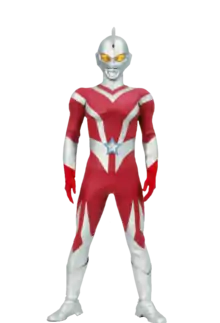Toru Narita
Toru Narita also known as Tohl Narita and Narita Tōru (1929–2002) was a Japanese visual artist who is best known for creating the characters and mechanics for the Ultra series of television programs: Ultraman (1966–7), Ultra Q (1966) and Ultra Seven.
Toru Narita | |
|---|---|
_Narita%252C_visual_artist_and_creator_of_Ultraman.jpg.webp) Toru Narita at the drawing table | |
| Born | September 3, 1929 Kobe, Japan |
| Died | February 26, 2002 |
| Nationality | Japanese |
| Known for | Design and special effects for television fantasy action shows, graphic arts |
| Website | tohlnarita |

Early life
Narita was born on September 3, 1929, in Kobe City, Japan. His family moved to Amori prefecture shortly after his birth.[1]
Career
Narita studied painting and sculpture at a Musashino Art University in Japan, and afterwards made part of his income doing special effects production work on the 1954 film Godzilla.[2] He then began working as a Tokusatsu (action film) artist for Toei starting in 1960; and in 1965 he began working for Tsuburaya Visual Effects Productions.[1] In addition to work as a designer, Narita was also a sculptor, painter, and director of special effects. He is best noted for his work on the Ultra series, known in the vernacular as "Narita's Monsters". He went on to work in TV special effects for the shows, Totsugeki! Human!!, Enban Senso Bankid, and Mighty Jack. In 1968 he became a freelance artist and worked on films and movies including Kono ko wo nokoshite, The Bullet Train, Mahjong horoki, and Senso to ningen.[2][1]
He continued to create and exhibit his oil painting and sculptures throughout his life, including a public art work, Demon Monument, located in Fukuchi City, Kyoto.[2] Narita's work was included in the Little Boy: The Arts of Japan's Exploding Subculture exhibition at the Japan Society in New York City. The exhibition featured his drawings "a favorite of otaku artists"; the series of drawings showed monsters transforming into buildings, stones and trees and other inanimate objects.[3] His work was the subject of a major retrospective exhibition at the Aomori Museum in 2015 that included 700 pieces of his work.[4] The show traveled to the Fukuoka Art Museum.[5]
A monograph was produced on his work, entitled “Narita Toru Illustration Works 成田亨作品集” (400 pages).[6] It is held in the Library of Congress.[7]
Collections
Narita's monster design prints held in the permanent collection of the Aomori Prefectural Art Museum,[2] and the Toyama Prefectural Museum of Art & Design.[8]
Death
Nartia died on February 26, 2002, at age 72, from multiple cerebral infarctions.[1]
References
- "The secrets behind the hero design for the movie Shin Ultraman Unveiled". Tsuburaya. Retrieved 3 August 2020.
- "Toru Narita-Fine Arts/Special Effects/Monsters 700 works on display! Largest retrospective in history". Aomori Museum. Retrieved 3 August 2020.
- Chin, Victoria. "More Than Just a Little Boy". UCLA International Institute. Retrieved 3 August 2020.
- "700 points of Toru Narita art / special effects / monster – exhibition scores! A retrospective show". Art-it. Retrieved 3 August 2020.
- "'Tohl Narita: Art/Special Effects/Monsters' Fukuoka Art Museum". Japan Times. Retrieved 3 August 2020.
- Yonghow. "Narita Toru Illustration Works Review". Halcyon Realms: Animation, Film, Photography. Retrieved 3 August 2020.
- "The art of Tohl Narita (Narita Tōru sakuhinshū /)". Library of Congress. Retrieved 3 August 2020.
- "Collections: Toru Narita: Art, Special Effects, and Monsters – The Origins of Ultraman". Toyoma Prefectural Museum of Art & Design. Retrieved 3 August 2020.